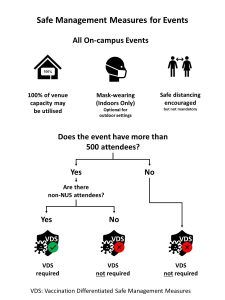Event Security and Safety Measures

In today’s fast-paced technology-driven world, events have become an integral part of our lives. From conferences and trade shows to music festivals and sporting events, these gatherings bring people together for a variety of purposes. However, with the increasing threat of security breaches and unforeseen incidents, event organizers must prioritize the safety and security of attendees, staff, and assets.
Understanding the Importance of Event Security
Event security encompasses a comprehensive set of measures designed to protect individuals and property during an event. It goes beyond traditional security practices and requires a deep understanding of technological advancements, crowd management, and crisis response. Without adequate security measures in place, the reputation and success of an event can be severely compromised.
1. Risk Assessment:
Every event is unique and comes with its own set of risks. Before organizing an event, a thorough risk assessment must be conducted to identify potential threats and vulnerabilities. This assessment involves evaluating the venue, crowd capacity, access points, and potential emergency scenarios. By identifying these risks early on, appropriate security measures can be implemented to mitigate them.
2. Robust Access Control Systems:
Controlling access to an event is crucial for maintaining security. Advanced technologies such as RFID wristbands, barcodes, and biometric systems can be employed to streamline attendee entry and ensure that only authorized individuals can enter restricted areas. This not only helps prevent unauthorized access but also allows for accurate attendance tracking and identification in case of any incident.
3. Video Surveillance and Monitoring:
Video surveillance plays a vital role in event security by providing real-time monitoring and recording of activities. With the advancements in video analytics, security personnel can detect suspicious behaviors, crowd movements, and potential threats. High-resolution cameras, strategically placed throughout the venue, along with intelligent video analytics algorithms, allow for quick response times and efficient crowd management.
4. Emergency Response Planning:
No matter how well an event is organized, there is always a possibility of unforeseen emergencies. It is crucial to have a comprehensive emergency response plan in place, detailing procedures for evacuation, medical emergencies, and communication protocols. The plan should be communicated to all staff members and regularly tested to ensure its effectiveness.
Technological Innovations for Event Security
The rapid advancements in technology have not only revolutionized the way we live but also the way we ensure event security. Here are some technological innovations that are transforming the event security landscape:
1. Facial Recognition:
Facial recognition technology has made significant strides in recent years. By analyzing facial features, event organizers can quickly identify individuals on watchlists or track suspicious activity in real-time. This technology adds an extra layer of security and enables efficient identification without relying solely on physical documents or security personnel.
2. Drones for Surveillance:
Drones equipped with high-definition cameras and thermal imaging capabilities have become an invaluable asset in event security. They provide a bird’s eye view of the venue, allowing security personnel to monitor the entire area more effectively. Drones can efficiently patrol large crowds, identify potential threats, and provide real-time situational awareness.
3. Mobile Applications:
Mobile applications have revolutionized the way event organizers communicate with attendees and manage security. Through a dedicated event app, organizers can send real-time alerts, provide emergency information, and enable attendees to report suspicious activities. Additionally, mobile applications can facilitate two-way communication between attendees and security personnel, enhancing overall event safety.
The Future of Event Security
The field of event security is constantly evolving, and new technologies continue to enhance safety measures. Here are some future trends that are expected to shape the industry:
1. Artificial Intelligence and Predictive Analytics:
Artificial intelligence and predictive analytics have the potential to revolutionize event security. By analyzing vast amounts of data, algorithms can identify patterns, predict potential threats, and enable proactive security measures. These technologies can help in anticipating crowd movements, detecting abnormal behaviors, and alerting security personnel in real-time.
2. Internet of Things (IoT):
The Internet of Things (IoT) allows different devices and systems to communicate and share data seamlessly. In the context of event security, IoT can enable interconnected systems such as video surveillance, access control, and emergency response systems. This integration improves response times and enhances overall event security by providing a holistic view of the situation.
3. Biometrics and Wearables:
Biometric technologies, such as fingerprint and iris scanners, combined with wearable devices, offer advanced identification and tracking capabilities. These technologies can ensure secure access for attendees, simplify verification processes, and enhance overall event safety. Biometric data, when securely managed, can also aid in investigations and post-event analysis.
In Conclusion
Event security and safety measures are of utmost importance in the tech-driven world we live in. By conducting thorough risk assessments, implementing robust access control systems, leveraging advanced technologies, and continuously adapting to emerging trends, event organizers can ensure the safety and well-being of all participants. The future of event security holds great promise, as technology continues to innovate and provide effective solutions to the challenges that lie ahead.